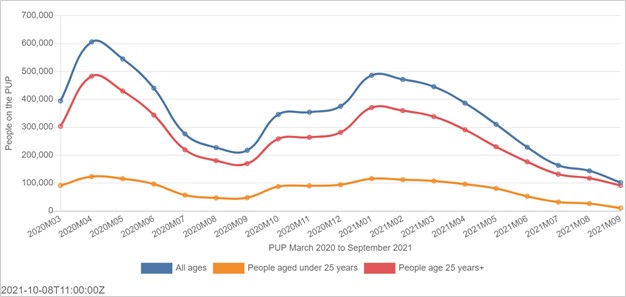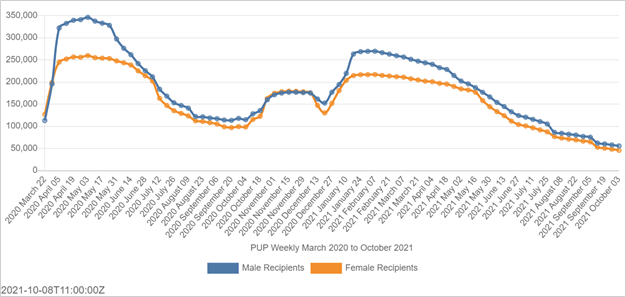When the Pandemic Unemployment Payment (PUP) was introduced in March 2020 few thought it would still be required in November 2021. Given the scale of the health crisis Ireland faced, a more straight forward and less complex application process for a PUP was introduced in comparison to the Jobseeker’s payment process. As a result a greater number of people were able to access it, in particular young people who may not have built up an entitlement to Jobseeker’s Benefit (insufficient PRSI contributions); or if they lived at home, their parents’ income would have been taken into account if they had applied for a Jobseeker’s Allowance payment, which is means-tested; or if they were full-time students who had lost part-time work.
Over the past nineteen months the Pandemic Unemployment Payment has undergone various changes. It has moved from the equivalent of a full working age payment, €203 to €350, the equivalent of a full claim plus a Qualified Adult payment rounded up to the nearest fifty. Then the payment levels were adjusted to reflect what a person earned previously and for a while there were four levels to the payment: €203; €250; €300; €350. This reflects the position with a Jobseeker’s Benefit payment, though the amounts payable are considerably lower at €91.10; €131.00; €159; and €203.
In early June, the Government published the National Economic Recovery Plan, and amongst the changes announced was an alignment of the PUP with the Jobseeker’s payments over a six month period from September 2021 until February 2022. As the country adapted to the on-going impact of the COVID-19 pandemic, the timescale set out in June was changed, though the payment for full-time students ended at the start of the 2021/2022 academic year in early September.
On the Department of Social Protection’s website they noted that “The process of moving from the lower €203 rate of PUP to a jobseeker’s payment was due to begin in early September. This has been deferred until after all sectors have started to re-open in line with the Roadmap announced on 31st August and all affected customers will continue to receive their PUP payment until 26th October when the process of their transition to a Jobseeker’s payment will begin.”
It is important to note that this transition is not automatic. Anyone on the lowest level of the PUP in mid-October expecting to receive a Jobseeker’s payment by the end of the month, should have applied for that payment by October 21st, 2021. The Department have stated that anyone in this position who has not applied to them for a Jobseeker’s, or more appropriate working age, payment will not receive a PUP after October 26th, 2021. This process will occur two more times: on November 16th, 2021 and February 8th, 2022.
Some Key PUP Statistics
According to the Department of Social Protection the highest number of recipients of the Pandemic Unemployment Payment occurred on May 4th, 2020 when there were 602,100 people on the payment. In 2021, the highest the figure went was on February 9th at 481,331 recipients. While, on October 19th, 2021 there were 93,399 people on the payment. Three sectors accounted for 44% of people on a PUP at this stage: accommodation and food service activities; wholesale and retail trade, repair of motor vehicles and motorcycles; administrative and support service activities. The first two sectors featured prominently in the February 2021 and May 2020 figures, while construction was the third highest sector, with administrative and support service activities ranked fourth.
According to the Central Statistics Office, 101,470 people were on the PUP in September, 2021. People aged under 25 years accounted for 10% of this figure, a similar percentage to that seen when the Live Register is broken down by age. In January 2021, 485,939 were on a PUP and young people accounted for 24% of this figure. While in April, 2020 there were 605,673 people on a PUP and at that stage young people accounted for 20%. The graph below shows the number of people on a Pandemic Unemployment Payment by age over the past nineteen months.

Looking at these figures from a gender perspective, the weekly figures in the graph below diverge at times when employment in the construction sector was more curtailed, a sector which remains predominantly male. According to the Labour Force Survey Quarter 2, 2021 women accounted for 8% of construction employment; 52% of accommodation and food services; 49% of wholesale and retail trade, repair of motor vehicles and motorcycles; and 35% of administrative and support service activities. The last three sectors accounted for 44% of PUP recipients in mid-October.

